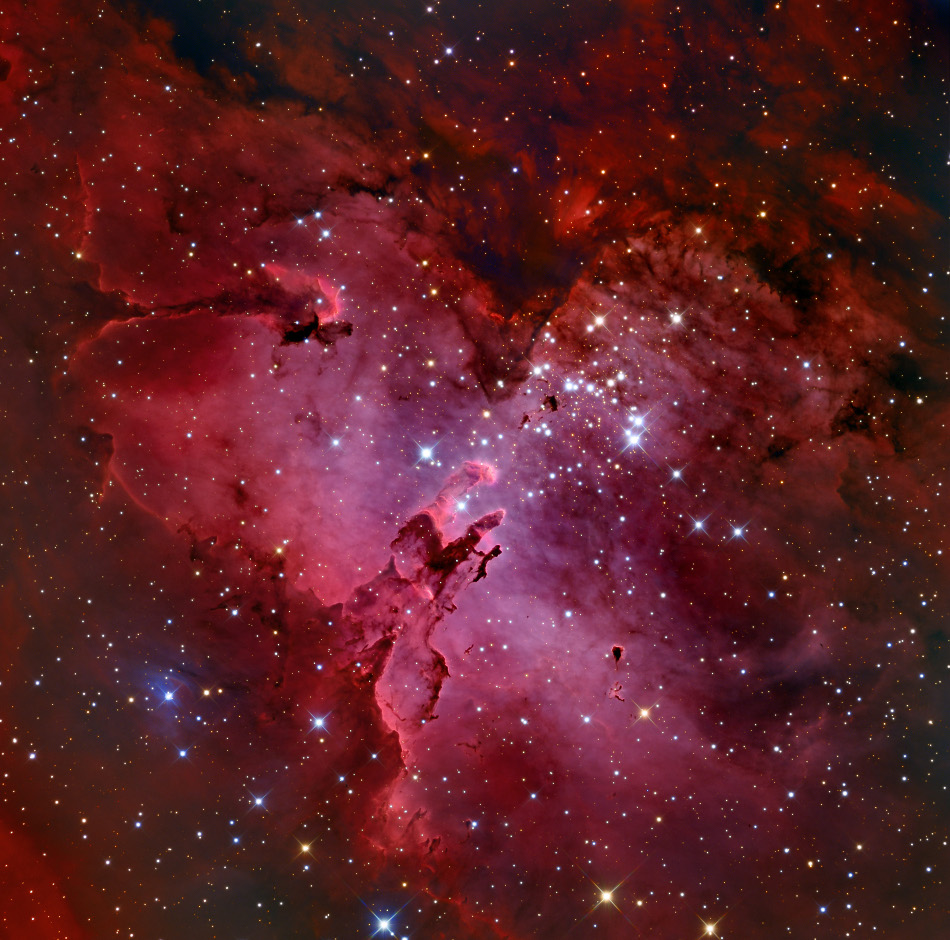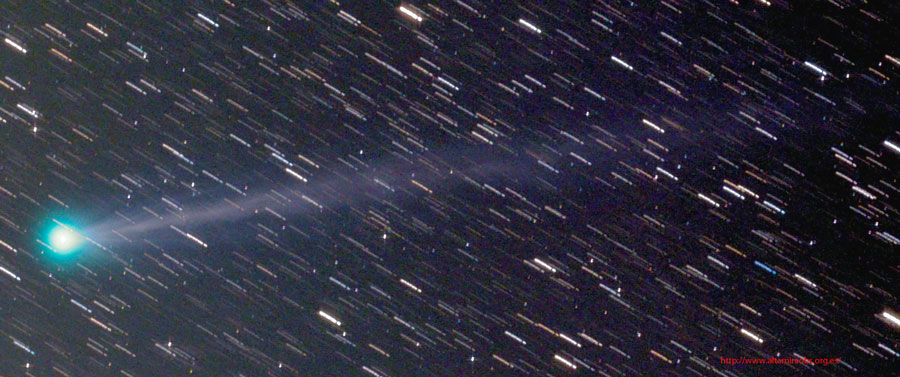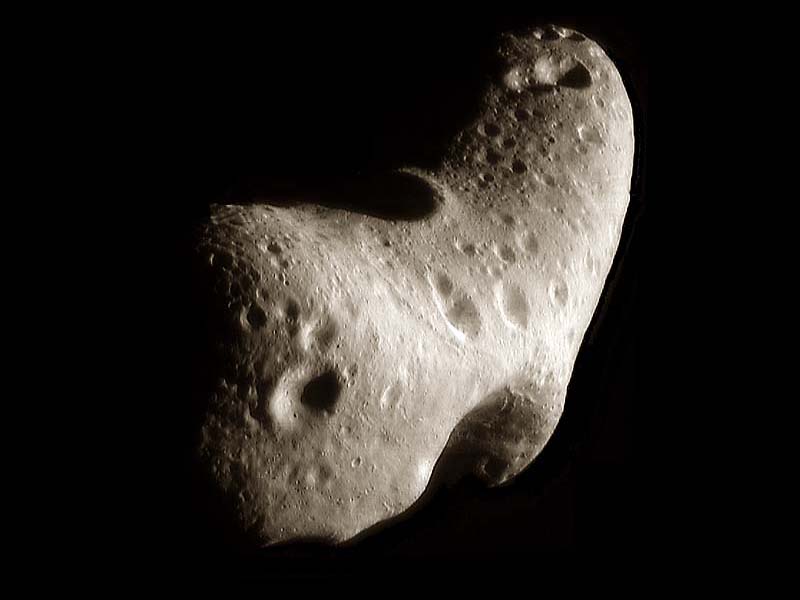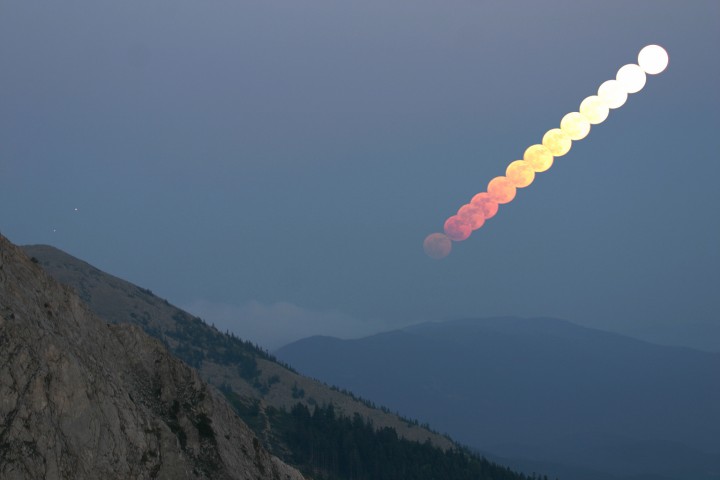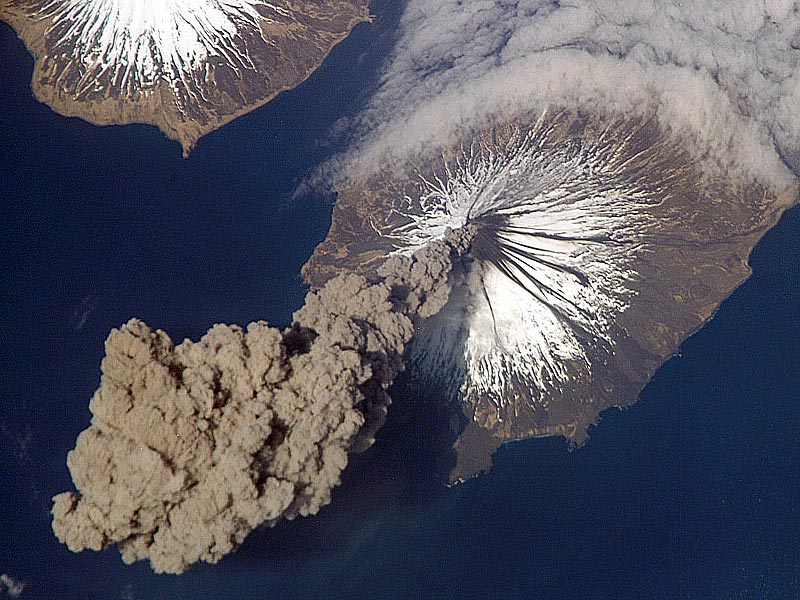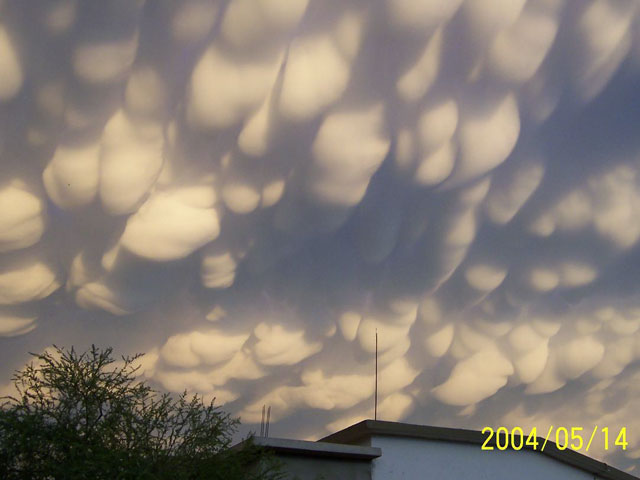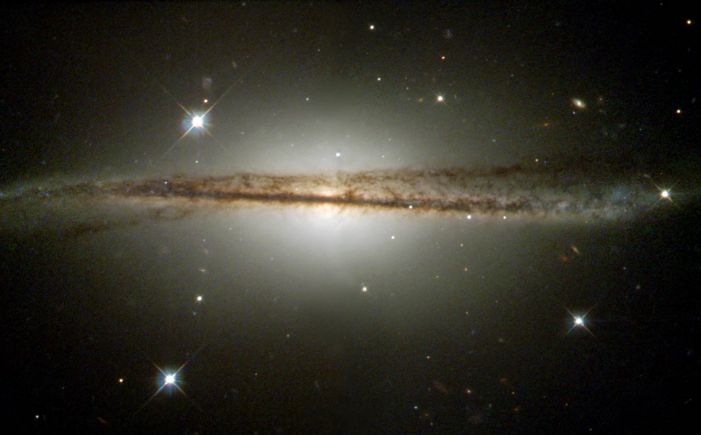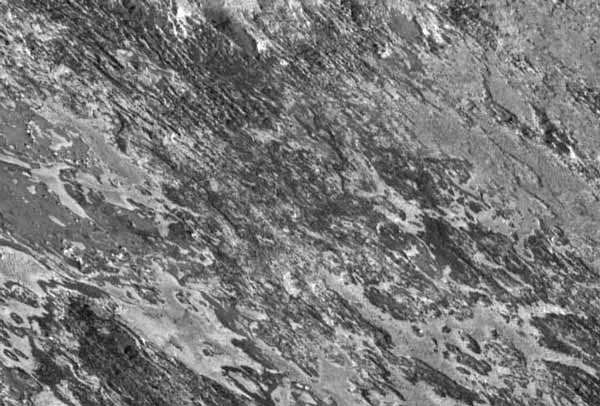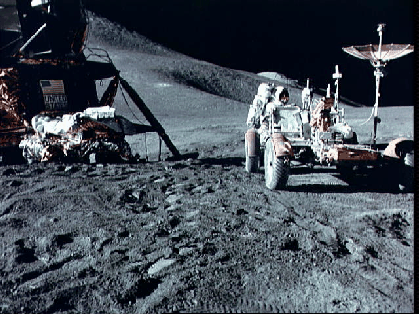| << Previous | Index | Next >> |
2015 It's the dim star, not the bright one, near the center of NGC 3132 that created this odd but beautiful planetary nebula. Nicknamed the Eight-Burst Nebula and the Southern Ring Nebula, the glowing gas originated in the outer layers of a star like our Sun. In this representative color picture, the hot blue pool of light seen surrounding this binary system is energized by the hot surface of the faint star. Although photographed to explore unusual symmetries, it's the asymmetries that help make this planetary nebula so intriguing. Neither the unusual shape of the surrounding cooler shell nor the structure and placements of the cool filamentary dust lanes running across NGC 3132 are well understood.
2014 A star cluster around 2 million years young, M16 is surrounded by natal clouds of dust and glowing gas also known as The Eagle Nebula. This beautifully detailed image of the region includes cosmic sculptures made famous in Hubble Space Telescope close-ups of the starforming complex. Described as elephant trunks or Pillars of Creation, dense, dusty columns rising near the center are light-years in length but are gravitationally contracting to form stars. Energetic radiation from the cluster stars erodes material near the tips, eventually exposing the embedded new stars. Extending from the left edge of the frame is another dusty starforming column known as the Fairy of Eagle Nebula. M16 and the Eagle Nebula lie about 7,000 light-years away, an easy target for binoculars or small telescopes in a nebula rich part of the sky toward the split constellation Serpens Cauda (the tail of the snake).
2013 The bright clusters and nebulae of planet Earth's night sky are often named for flowers or insects. Though its wingspan covers over 3 light-years, NGC 6302 is no exception. With an estimated surface temperature of about 250,000 degrees C, the dying central star of this particular planetary nebula has become exceptionally hot, shining brightly in ultraviolet light but hidden from direct view by a dense torus of dust. This sharp and colorful close-up of the dying star's nebula was recorded in 2009 by the Hubble Space Telescope's Wide Field Camera 3, installed during the final shuttle servicing mission. Cutting across a bright cavity of ionized gas, the dust torus surrounding the central star is near the center of this view, almost edge-on to the line-of-sight. Molecular hydrogen has been detected in the hot star's dusty cosmic shroud. NGC 6302 lies about 4,000 light-years away in the arachnologically correct constellation of the Scorpion (Scorpius).
2012 Occurring in pairs separated by over a hundred years, there have now been only eight transits of Venus since the invention of the telescope in 1608. The next will be in December of 2117. But many modern telescopes and cameras were trained on this week's Venus transit, capturing the planet in rare silhouette against the Sun. In this sharp telescopic view from Georgia, USA, a narrowband H-alpha filter was used to show the round planetary disk against a mottled solar surface with dark filaments, sunspots, and prominences. The transit itself lasted for 6 hours and 40 minutes. Historically, astronomers used timings of the transit from different locations to triangulate the distance to Venus, while modern astronomers actively search for planets that transit distant suns.
2011 Space shuttle Endeavour is home to stay. In a rare night landing last week, Endeavour glided onto a runway in Cape Canaveral, Florida, USA completing a 16-day mission that included a visit to the International Space Station (ISS). All told, space shuttle Endeavour flew 25 flights since being deployed by NASA in 1992, spending a total of 299 days in space. Endeavour's next mission will be a stationary one in the California Science Center. Even as Endeavour was landing, the space shuttle Atlantis was being rolled out in preparation for the last mission of any Space Shuttle, a mission currently scheduled to begin on July 8.
2010 A new comet is brightening and is now expected to become visible to the unaided eye later this month. C/2009 R1 (McNaught) is already showing an impressive tail and is currently visible through binoculars. The above image, taken yesterday from the Altamira Observatory in the Canary Islands and spanning about five degrees, shows an impressive green coma and a long ion tail in front of distant star trails. Although predicting the brightness of comets is notoriously difficult, current estimates place Comet McNaught as becoming visible to unaided northern hemisphere observers in late June, before sunrise, and in early July, after sunset. Discovered by Robert McNaught last year, the sun-orbiting iceberg will pass the Earth next week and will continue to melt and shed debris as it closes in on the Sun until early July. After reaching about half of the Earth-Sun distance from the Sun, the comet should fade rapidly as it then heads out of the inner Solar System.
2009 Orbiting the Sun between Mars and Earth, asteroid 433 Eros was visited by the robot spacecraft NEAR-Shoemaker in 2000 February. High-resolution surface images and measurements made by NEAR's Laser Rangefinder (NLR) have been combined into the above visualization based on the derived 3D model of the tumbling space rock. NEAR allowed scientists to discover that Eros is a single solid body, that its composition is nearly uniform, and that it formed during the early years of our Solar System. Mysteries remain, however, including why some rocks on the surface have disintegrated. On 2001 February 12, the NEAR mission drew to a dramatic close as it was crash landed onto the asteroid's surface, surviving well enough to return an analysis of the composition of the surface regolith. In December of 2002, NASA made an unsuccessful attempt to communicate with the spacecraft after it spent 22 months resting on the asteroid's surface. NEAR will likely remain on the asteroid for billions of years as a monument to human ingenuity at the turn of the third millennium.
2008 Serene skyviews were enjoyed across planet Earth earlier this week with a young crescent Moon low in the western sky just after sunset. Recorded on June 4, this colorful example includes a quiet beach in the foreground with the city lights of Lisbon, Portugal, and the Sintra Mountains along the horizon. Posing between cloud banks, the Moon's slender, sunlit arc represents only about 1 percent of the full lunar disc. The rest of the Moon's nearside is faintly visible though, illuminated by Earthshine. A waxing crescent Moon should also create some lovely western skies at dusk this weekend. The bright star in the sky near tonight's (Saturday's) Moon will actually be the planet Mars. On Sunday the Moon will move closer to a pair of celestial beacons, bright star Regulus and Saturn.
2007 On May 31st, a gorgeous Full Moon rose over Uludag Mountain in Bursa Province, Turkey. This alluring telephoto view of the twilight scene is a composite of images taken roughly every two minutes beginning shortly after Sunset, following the rising Moon as it moves up and to the right. Of course, as the Moon rises it gets brighter and changes color, becoming less reddened as the sight-line through the dense atmosphere is steadily reduced. Each of the final two exposures also captured a rising planet Jupiter. Like the Full Moon, the bright, wandering planet is nearly opposite the Sun in Earth's sky and was caught on the lefthand side of the picture in two places, just above a small peak in the mountain side. Intriguingly, some considered this Full Moon a Blue Moon.
2006 What is happening to that volcano? It's erupting! The first person to note that the Aleutian Cleveland Volcano was spewing ash was astronaut Jeffrey N. Williams aboard the International Space Station. Looking down on the Alaskan Aleutian Islands two weeks ago, Williams noted, photographed, and reported a spectacular ash plume emanating from the Cleveland Volcano. Starting just before this image was taken, the Cleveland Volcano underwent a short eruption lasting only about two hours. The Cleveland stratovolcano is one of the most active in the Aleutian Island chain. The volcano is fueled by magma displaced by the subduction of the northwest-moving tectonic Pacific Plate under the tectonic North America Plate.
2005 Galaxies abound in this cosmic scene, a well chosen telescopic view toward the northern constellation of Ursa Major. Most noticeable are the striking pair of spiral galaxies - NGC 3718 (above, right) and NGC 3729 (below center) - a mere 52 million light-years distant. In particular, NGC 3718 has dramatic dust lanes sweeping through its bright central region and extensive but faint spiral arms. Seen about 150 thousand light-years apart, these two galaxies are likely interacting gravitationally, accounting for the warped and peculiar appearance of NGC 3718. While a careful study of the deep image reveals a number of fainter and more distant background galaxies, another remarkable galaxy grouping known as Hickson Group 56 can be found just to the right of NGC 3718. Hickson Group 56 contains five interacting galaxies and lies over 400 million light-years away.
2004 When do cloud bottoms appear like bubbles? Normal cloud bottoms are flat because moist warm air that rises and cools will condense into water droplets at a very specific temperature, which usually corresponds to a very specific height. After water droplets form that air becomes an opaque cloud. Under some conditions, however, cloud pockets can develop that contain large droplets of water or ice that fall into clear air as they evaporate. Such pockets may occur in turbulent air near a thunderstorm, being seen near the top of an anvil cloud, for example. Resulting mammatus clouds can appear especially dramatic if sunlit from the side. The above mammatus clouds were photographed last month over Monclova, Mexico.
2003 How did spiral galaxy ESO 510-13 get bent out of shape? The disks of many spirals are thin and flat, but not solid. Spiral disks are loose conglomerations of billions of stars and diffuse gas all gravitationally orbiting a galaxy center. A flat disk is thought to be created by sticky collisions of large gas clouds early in the galaxy's formation. Warped disks are not uncommon, though, and even our own Milky Way Galaxy is thought to have a small warp. The causes of spiral warps are still being investigated, but some warps are thought to result from interactions or even collisions between galaxies. ESO 510-13 is about 150 million light years away and about 100,000 light years across.
2002 This infant solar system was discovered posing along the lonely outskirts of the Rho Ophiuchi dark cloud, a star forming region 500 light-years from Earth. Enlarged in an infrared false-color portrait from the European Southern Observatory's Antu telescope, the dark dusty disk of planet-forming material lies edge-on, neatly dividing two small nebulae which reflect light from a hidden, youthful central star. Enthusiastically nicknamed the "Flying Saucer", the circumstellar disk is about 300 astronomical units across (1 a.u. is the Earth-Sun distance) or about 5 times the diameter of Neptune's orbit. The twin reflection nebulae have clearly different colors for reasons which still remain a mystery, but the relatively isolated neighborhood of the natal solar system is a stroke of luck. Planets should be able to develop within the dusty disk free from the destructive influence of radiation and winds from any nearby massive hot stars usually found in young star clusters.
2001 Astronomers now report that Chandra X-ray Observatory observations of galaxies known to be frantically forming stars show that these galaxies also contain luminous x-ray sources -- thought to be intermediate mass black holes and immense clouds of superheated gas. Take the lovely island universe NGC 253 for example. At distance of a mere 8 million light-years, NGC 253's prodigious starforming activity has been well studied using high-resolution optical images like the one seen here at lower left. Zooming in on this energetic galaxy's central region, Chandra's x-ray detectors reveal hidden details indicated in the inset at right. In the false-color image, x-ray hot gas clouds glow near the core and at least four very powerful x-ray sources lie within 3,000 light-years of the center of the galaxy. Much more luminous than black hole binary star systems in our own galaxy, these extreme x-ray sources may be gravitating toward NGC 253's center. As a result, NGC 253 and other similar starforming galaxies could ultimately develop a single, central, supermassive black hole, transforming their cores into quasars.
2000 Above is the highest resolution photograph yet taken of the Solar System's strangest moon. The surface of Jupiter's moon Io is home to violent volcanoes that are so active they turn the entire moon inside out. The above photograph shows a region four kilometers across and resolves features only five meters across. Many revealed details are not well understood. In general, the bright areas are higher terrain than the darker areas, but some areas of the surface appear eroded by an unknown process. Although the parts of Io's surface near erupting volcanoes are hot enough to melt rock, most of Io has cooled well below the freezing point of water. The robot spacecraft Galileo during its most recent flyby of Io took the above image in 2000 February.
1999 Tremendous pillars of gas and dust are being boiled away in the Trifid Nebula. In the center of the picturesque Trifid lies a young hot star, located above and to the right of this picture. As soon as it was born, the massive star scorched its surroundings with bright and energetic light. Nearby stars trying to form ended up starved for gas as it was swept away from them by the bright star's light and wind. Lower mass stars should continue to form in the Trifid Nebula, as over 1500 times the mass of our Sun still exists in uncondensed gas. Also known as M20, the Trifid Nebula is about 9000 light years away and easily visible with a small telescope in the constellation of Sagittarius.
1998 Galaxies like colorful pieces of candy fill the Hubble Deep Field - humanity's most distant yet optical view of the Universe. The dimmest, some as faint as 30th magnitude (about four billion times fainter than stars visible to the unaided eye), are the most distant galaxies and represent what the Universe looked like in the extreme past, perhaps less than one billion years after the Big Bang. To make the Deep Field image, astronomers selected an uncluttered area of the sky in the constellation Ursa Major (the Big Bear) and pointed the Hubble Space Telescope at a single spot for 10 days accumulating and combining many separate exposures. With each additional exposure, fainter objects were revealed. The final result can be used to explore the mysteries of galaxy evolution and the infant Universe.
1997 Apollo 15 astronaut James Irwin works on the first Lunar Roving Vehicle, before he and fellow astronaut David Scott take it out for a drive. Sloping up behind the lunar module "Falcon" on the left are lunar mountains Hadley Delta and Apennine Front, while about 5 kilometers behind Irwin is St. George Crater. The explorations conducted during the Apollo lunar missions discovered much about our Moon, including that the Moon is made of ancient rock, that the Moon's composition is similar to Earth's, that life is not evident there, that the Moon underwent a great hot melting in its distant past, that the Moon has suffered from numerous impacts as shown by its craters, and that the Moon's surface is covered by a layer of rock fragments and dust.
1996 Apollo 16 spent three days on Earth's Moon in April 1972. The fifth lunar landing mission out of six, Apollo 16 was famous for deploying and using an ultraviolet telescope as the first lunar observatory, and for collecting rocks and data on the mysterious lunar highlands. In the above picture, astronaut John W. Young photographs Charles M. Duke, Jr. collecting rock samples at the Descartes landing site. Duke stands by Plum Crater while the Lunar Roving Vehicle waits parked in the background. The Lunar Roving Vehicle allowed the astronauts to travel great distances to investigate surface features and collect rocks. High above, Thomas K. Mattingly orbits in the Command Module.
| << Previous | Index | Next >> |

